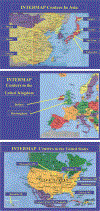INTERMAP: background, aims, design, methods, and descriptive statistics (nondietary)
- PMID: 13679950
- PMCID: PMC6660162
- DOI: 10.1038/sj.jhh.1001603
INTERMAP: background, aims, design, methods, and descriptive statistics (nondietary)
Abstract
Blood pressure (BP) above optimal (< or =120/< or =80 mmHg) is established as a major cardiovascular disease (CVD) risk factor. Prevalence of adverse BP is high in most adult populations; until recently research has been sparse on reasons for this. Since the 1980s, epidemiologic studies confirmed that salt, alcohol intake, and body mass relate directly to BP; dietary potassium, inversely. Several other nutrients also probably influence BP. The DASH feeding trials demonstrated that with the multiple modifications in the DASH combination diet, SBP/DBP (SBP: systolic blood pressure, DBP: diastolic blood pressure) was sizably reduced, independent of calorie balance, alcohol intake, and BP reduction with decreased dietary salt. A key challenge for research is to elucidate specific nutrients accounting for this effect. The general aim of the study was to clarify influences of multiple nutrients on SBP/DBP of individuals over and above effects of Na, K, alcohol, and body mass. Specific aims were, in a cross-sectional epidemiologic study of 4680 men and women aged 40-59 years from 17 diverse population samples in China, Japan, UK, and USA, test 10 prior hypotheses on relations of macronutrients to SBP/DBP and on role of dietary factors in inverse associations of education with BP; test four related subgroup hypotheses; explore associations with SBP/DBP of multiple other nutrients, urinary metabolites, and foods. For these purposes, for all 4680 participants, with standardized high-quality methods, assess individual intake of 76 nutrients from four 24-h dietary recalls/person; measure in two timed 24-h urine collections/person 24-h excretion of Na, K, Ca, Mg, creatinine, amino acids; microalbuminuria; multiple nutrients and metabolites by nuclear magnetic resonance and high-pressure liquid chromatography. Based on eight SBP/DBP measurements/person, and data on multiple possible confounders, utilize mainly multiple linear regression and quantile analyses to test prior hypotheses and explore relations of multiple dietary and urinary variables to SBP/DBP of individuals. The 4680 INTERMAP participants are equally divided across four age/gender strata: diverse in ethnicity, education, occupation, physical activity; use of cigarettes, alcohol; diagnosed high BP, CVD, diabetes; CVD family history; women vary in parity, use of contraceptive medication and hormone replacement therapy.
Figures
References
-
- Joint National Committee on the Detection, Evaluation, and Treatment of High Blood Pressure (JNC-V). Fifth Report of the Joint National Committee on the Detection, Evaluation, and Treatment of High Blood Pressure (JNC-V). Arch Intern Med 1993; 153: 154–183. - PubMed
-
- National High Blood Pressure Education Program Working Group. Report on the primary prevention of hypertension. Arch Intern Med 1993; 153: 186–208. - PubMed
-
- National High Blood Pressure Education Program. The Sixth Report of the Joint National Committee on Prevention, Detection, Evaluation, and Treatment of High Blood Pressure (JNC-VI) NIH Publication No. 98–4080. National Institutes of Health, National Heart, Lung, and Blood Institute: Bethesda, MD, 1997.
-
- Whelton PK et al., for the National High Blood Pressure Education Program Coordinating Committee. Primary prevention of hypertension: clinical and public health advisory from the National High Blood Pressure Education Program. JAMA 2002; 288: 1882–1888. - PubMed
-
- Stamler J, Greenland P, Neaton JD. The established major risk factors underlying epidemic coronary and cardiovascular disease. CVD Prev 1998; 1: 82–97.
Publication types
MeSH terms
Substances
Grants and funding
LinkOut - more resources
Full Text Sources
Other Literature Sources
Medical


